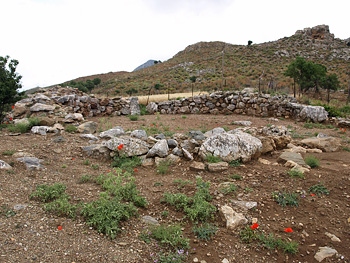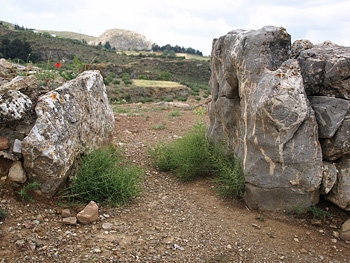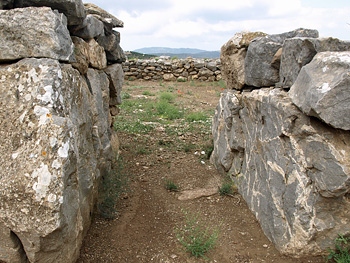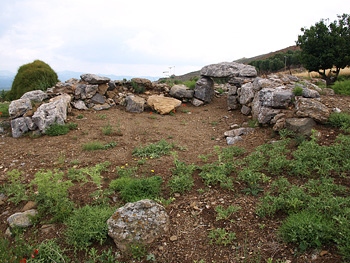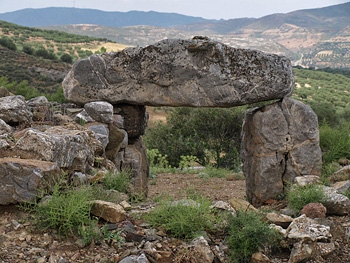
The Prepalatial cemetery of Koumasa lies between the villages of Loukia and Koumasa on the south of the Messara plain at the foot of the Asterousia mountains. The site was excavated from 1904 to 1906 by Xanthoudides and hasn't been excavated since.
There are four tombs on the site, three tholos tombs and a square tomb.
Tholos B
Since the bedrock was only a few centimetres below the surface, it was simply necessary to dig down to the bedrock and then construct the circular wall. This is built of undressed stones held together with clay. The tomb was corbelled, which means that each course of stones projects inwards above the course below forming a beehive shape. The entrance was on the east as is the case with all Mesara tholos tombs. The entrance was made of large stone uprights supporting a huge lintel and together these are known as a trilithon (three stones). The large upright stones and the lintel, as well as the two stone slabs that would have sealed the entrance to the tomb, had been removed by villagers in the past.
Tholos B has an internal diameter of 9.52 metres and the thickness of the wall is between 1.60m and 2 m, giving an outside diameter of around 13.50 m. This makes Tholos Beta larger than the average tholos tomb. The wall is preserved for the whole circumference at heights varying from 1.60 m on the east side to just a few centimetres on the west and southwest parts. Unusually the entrance to this tholos was divided into two by a large upright rock fixed deep in the ground. The opening on either side of this upright rock is about one metre.
On the outside of the northern section five slabs project a short distance from the surface of the wall at a height of about one metre from the ground. The exact purpose of these slabs is not known. Xanthoudides suggests that a stone-lined pit must have existed just in front of the doorway.
East of the tomb, beyond a partially preserved wall was a paved court, forming an irregular circle with a diameter of about 6.50 m, which extends in front of Tholos E. Xanthoudides stated that he found signs of fires having been lit on the floor of the tomb and claimed to have seen the marks of a large hearth in the middle of the floor and under a hole in the roof which he suggested would have been there to let smoke out of the tomb. If this was the case then the tomb was not completely vaulted but had a less permanent roof that could be removed and replaced at will. Blackened bones also pointed to fires having been lit in the tomb.
The large number of bones discovered during the excavation suggests that hundreds of people had been interred in the tomb over a long period of time. Unfortunately the bones had been moved about within the tomb, either to make way for fresh burials or during looting, so it was not possible to determine how the bodies were placed in the tomb at the time of burial.
Finds from Tomb B
Xanthoudides noted that most of the valuable grave goods had been removed from the tomb long ago. Clay vessels found in Tholos B included three cylindrical pyxides, a number of jugs, anthropomorphic and zoomorphic vases and lamps. Stone vessels were more numerous and more important than the clay finds. Seven stone objects like small tables were found in the tomb. Although these resembled palettes for mixing colours which had been found in tombs in the Cyclades, Xanthoudides seemed unsure whether these were in fact palettes because, unlike the other examples, no trace of colouring was found on them. An alternative explanation is that they were in fact sacred offering tables. About eighty stone vases were found in the tomb, a number only exceeded at Platanos, where about three hundred were found inside and outside of Tholos A. These included multiple vases or kernoi, that is a rectangular piece of stone with two or four "vases" scooped out, bird's nest vases and bowls. It is almost certain that these came from MM I. Large quantities of obsidian blades were also recovered.
A number of figurines were found in Tholos B and these can be divided into two groups, those resembling Cycladic figurines and Cretan figurines. Two of the six Cycladic figurines found at Koumasa came from Tholos B. All six represented naked women. It seems likely that three of these figurines carved from island marble were imported from the Cyclades. The other three, carved from rough limestone, may have come from the islands or may have been manufactured in Crete. Xanthoudides suggested that they represented a Mother Goddess. Three figurines had been deliberately broken before being placed in the tomb and had therefore probably been used previous to the burial as sacred figures of worship or as amulets. Most of the six Cretan figurines found in Tholos B show women wearing dresses down to their feet. Their hands cover their breasts. These finds probably date to EM IIA.
Over twenty copper daggers were discovered in the Tholos B and they were of two types. The smaller, triangular daggers were similar to others found elsewhere in Greece and even in the islands, as well as much of Bronze Age Europe. The second type were long daggers. Xanthoudides speculates that the large number of daggers found in various tombs in the Mesara meant that men wore their daggers both in life and in death. Other small metal objects including cutters, hair tweezers, pins and awls were also found. Despite extensive looting from the earliest times a few gold objects were found including a pendant in the shape of a squatting toad, three gold beads from necklaces and bands of gold sheeting. These probably date to a later period and may even be MM I deposits.
About twenty seals, made from ivory or stone, were uncovered. The most interesting seal is a representation in ivory of a dove protecting her two young with her wings. Finally, a number of pendants and necklaces were found made from various materials, mainly steatite.
Tholos Tombs A, E and G
The smallest of the tholoi is Tholos A, located just north of Tholos B. A large part of the circular wall has disappeared. The inner diameter is 4.10 m and the thickness of the wall is 1.30 m. At its highest, by the entrance, the wall stands to 1.20 m. The doorway is a trilithon, with two upright slabs supporting a massive block of limestone as a lintel. Originally there was an antechamber in front of the entrance.
Tholos E, with a diameter of 9.3 metres, is also larger than average. The circuit of its wall remains complete. The wall still stands to a height varying from one metre to 1.50 m and the thickness averages around two metres. The slab which covered the entrance was found in place. On either side of the doorway there are a total of twelve slabs projecting out in a row about 0.30 m above the ground. The lintel is preserved in situ and consists of two massive blocks of stone. In front of the entrance there is an antechamber. Xanthoudides suggests that access to this antechamber, and thus to the tomb itself, would have been by a ladder or steps. He also suggests that there may have been other chambers in front of the antechamber where offerings would have been made but there is no trace of such structures today. In Tholos E all the bones had been placed in a heap in the western part of the tomb and covered with white earth.
There is also a rectangular tomb Gamma which almost touches Tholos E to the north. The whole of the western wall of tomb Gamma is missing. The tomb measures 4.20 m wide and the length of what remains is 4.10 though obviously it would have been longer originally. Xanthoudides suggests that it may have had a wooden roof. Few finds were discovered inside the building.
A paved area which lies to the southeast of Tholos E has been named Area Zeta. Although they lack any architectural features three more areas of importance have been identified at the site and named Areas AB, BE and Delta. In these areas burials and grave objects were found by the excavator.
Finds from the remaining tombs
Clay finds from these tombs included vases in various styles, beaked jugs, bowls and cups as well as vessels in the form of people or animals. Stone objects include palettes (see discussion above), pyxides and stone vases. The four figurines have been mentioned above.
Eleven copper daggers were found inside or around these tombs, three triangular ones and eight long ones. An unusual find here were three silver daggers that came from the square tomb Gamma. Silver was an extremely rare commodity in Bronze Age Crete and possession of these silver daggers may have attested to the high status of the owner. A small amount of gold was found as well as thirteen seals, five of ivory in poor condition and eight of steatite.
As at Tomb B, a few pendants and necklace beads were uncovered and four "whorls" of steatite, too small to be spindle whorls and therefore of unkown use, were found in Area D. The EM IIA Koumasa style of vases took its name from finds removed from this site.
Chronology
Since none of the objects recovered from the cemetery date before EM IIA, it seems likely that Tholoi A and B, together with the rectangular Tomb Gamma were built in EM IIA. Tholos E and Area Zeta may also date from EM IIA but there is insufficient evidence to be certain. Evidence for the use of these tombs in EM III-MM IA comes mainly from the upper stratum found in Tholos B.
As mentioned above, like a number of other Early Minoan tholos tombs, two of the tombs here, A and E, have an antechamber at the entrance to the tomb. Here, however, it is limited to just one room in front of each tomb. It is thought that tomb B also had an antechamber but there is little sign of it today. However, there is no fully formed annexe at the cemetery, like there is at, for example, Odiyitria or Yerokambos, even though the cemetery went through periods of change in later periods when other cemeteries were having annexes added. However, Xanthoudides, in his original report, claimed that there would have been a number of other structures around the cemetery but he argued that their construction was likely to have been more flimsy so that no trace of them remains today.
It is possible that two of the tombs, A and Gamma went out of use after EM IIA and Tholos E was either built then or at least became more important. As mentioned above, no major architectural changes were made to the cemetery during this period whereas at other tholos tombs in the Mesara and the Asterousia Mountains, annexes of overflow burial chambers and additional rooms for offerings were added. Instead, Tholos Tombs B and E became the two main tombs as A and Gamma were shut down.
The settlement
The settlement associated with the cemetery seems to have been located above the cemetery on a twin-peaked hill called Korakies. Unfortunately virtually nothing remains of this settlement today. The finds that Xanthoudides found on the site date to a later period which led him to believe that the settlement remained in use from Early Minoan times right through to the Middle Minoan and even the Late Minoan.
SOURCES: The main sources for this article were "The Vaulted Tombs of the Mesara" by Xanthoudides and "Secret Lives of EM and MM cemeteries" by Legarra-Herrero.


